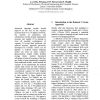Free Online Productivity Tools
i2Speak
i2Symbol
i2OCR
iTex2Img
iWeb2Print
iWeb2Shot
i2Type
iPdf2Split
iPdf2Merge
i2Bopomofo
i2Arabic
i2Style
i2Image
i2PDF
iLatex2Rtf
Sci2ools
ACL
2006
2006
Reduced n-gram Models for English and Chinese Corpora
Statistical language models should improve as the size of the n-grams increases from 3 to 5 or higher. However, the number of parameters and calculations, and the storage requirement increase very rapidly if we attempt to store all possible combinations of n-grams. To avoid these problems, the reduced n-grams' approach previously developed by O'Boyle (1993) can be applied. A reduced n-gram language model can store an entire corpus's phrase-history length within feasible storage limits. Another theoretical advantage of reduced n-grams is that they are closer to being semantically complete than traditional models, which include all n-grams. In our experiments, the reduced n-gram Zipf curves are first presented, and compared with previously obtained conventional n-grams for both English and Chinese. The reduced n-gram model is then applied to large English and Chinese corpora. For English, we can reduce the model sizes, compared to 7-gram traditional model sizes, with fact...
| Added | 30 Oct 2010 |
| Updated | 30 Oct 2010 |
| Type | Conference |
| Year | 2006 |
| Where | ACL |
| Authors | Le Quan Ha, Philip Hanna, Darryl Stewart, F. Jack Smith |
Comments (0)

